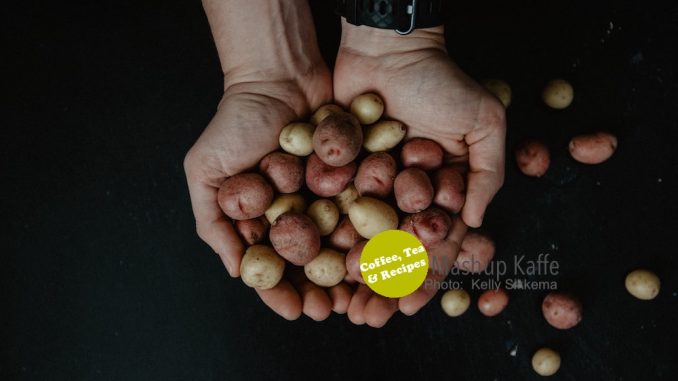
Every so often we get into the potato conversation at our house, this morning was one of those. I don’t remember things off-hand, so this is a list that I can look up when I’m planning my menu, or making a shopping list. At the very least, it’s a handy bookmark that I can look at it while I’m shopping to make sure I get the right potato.
Reach for waxy potatoes for boiling, roasting and baking preparations where the potato stays intact, such as casseroles, gratins, potato salad, soups, and stews. New Potatoes, French fingerling, Red Bliss, baby potatoes, creamers, Red Adirondack, and Russian Banana are all waxy varieties.
Don’t overwork starchy potatoes; if you keep stirring them when making mashed potatoes, they will become gluey
What’s the difference between starchy, waxy potatoes, and all purpose?
Starchy potatoes have low moisture and sugar levels, but a high starch content. This makes them the better potato for baked, mashed, fried, or roasted potatoes. With the low sugar content they collapse better.
Like the classic Idaho or Russet, these potatoes are (obviously) high in starch and low in moisture. They’re fluffy, making them great for boiling, baking and frying, but they don’t hold their shape well, so they should be avoided in dishes like casseroles, gratins and potato salads.
Waxy potatoes are just the opposite, with high moisture levels and low starch levels. They are good candidates for salads or casseroles because they hold their shape well when cooking.
Like Red Bliss or New Potatoes, these have a low starch content and are often characterized by a creamy, firm and moist flesh that holds its shape well after cooking. They’re typically great for roasting, boiling, casseroles and potato salads.
These potatoes have a medium starch content that fall somewhere in between the starchy and waxy potatoes. They’re a true multi-purpose potato, and therefore can be used for just about any cooking application. A classic example is the Yukon Gold.
White potatoes are considered all-purpose as they are slightly creamy, slightly dense, and are subtly sweet in flavour. These potatoes hold their shape well after cooking and are a popular choice for salads and for grilling. Yellow potatoes are slightly waxy in texture, velvety, and moist.
Blue: Waxy. Medium skin with an earthy flavour and vibrant colour. Baked or roasted, salads, steamed, microwaved.
Fingerling: Waxy. Nutty and buttery flavour with a firm texture. Baked or roasted, pan fried or sautéed, steamed, microwaved.
Petite: Similar in taste to their larger sized cousins with more concentrated flavours. Baked or roasted, pan fried or sautéed, steamed, microwaved.
Purple: Waxy. Medium skin with an earthy flavour and vibrant colour. Baked or roasted, salads, steamed, microwaved.
Red: Waxy. Thin skin and stays firm throughout cooking. Baked or roasted, salads, soups or stews, grilled, steamed.
Russet: Starchy. thick skin with light and fluffy centre. Baked or roasted, pan fried or sautéed, mashed, fried.
Russets are the potato of choice for baking and frying with a finished product that is crispy on the outside and fluffy on the inside. They also make heavenly mashed potatoes—light and fluffy.
White: All purpose. Thin skin with a nutty flavour and stays firm throughout cooking. Pan fried or sautéed, salads, soups or stews, fried, steamed.
Yellow: All purpose-Slightly waxy. Buttery flavour with a creamy texture. Baked or roasted, mashed, salads, soups or stews, grilled.
Making Sense of Common Potato Terms
How do waxy and floury potatoes differ? What’s a “new” potato?
Waxy potatoes display a creamy, firm texture when cooked, thanks to their low starch and high water content. Waxy potatoes also keep their shape when cooked, making them ideal for boiling, steaming and roasting.
Floury potatoes are low in water content; and by the time of harvest, most of their sugar has converted to starch. This leads to a dry, fluffy cooked texture accentuated by baking and mashing. Floury potatoes also fry well, as low sugar levels mean less excessive browning.
“New potatoes” is a term often used to market round red potatoes, and in this case, “new” technically refers to any type of potato that is harvested before reaching full size.
Source: Potato Goodness
https://www.potatogoodness.com/potato-types/
https://www.potatogoodness.com/wp-content/uploads/2019/08/BrochureFresh-Update-Singles.pdf
https://www.marthastewart.com/1539281/potato-guide-starchy-waxy-all-purpose
https://www.mainepotatoes.com/faqs/whats-the-difference-between-starchy-and-waxy-potatoes/
https://www.huffpost.com/entry/types-of-potatoes_n_4877050
